Cleaning Door Jambs and Other Filthy Places on an Otherwise Clean Car
by Marc Harris & Jacob BunyanSo your car is squeaky clean, waxed and buffed to the max. Your wheels are clean enough to eat off, as is your engine bay. You revel in the shine and gloss of your beautiful ride. You open the door to jump inside and take a drive…
As you sit down, you notice an obscure area, visible only in a flash. You look again; it’s your doorjamb looking straight back at you. It is dark, uninviting, and elusive. As you disregard the neglected doorjamb and start to close the door, a ray of light shines through and lights up the dark crevice: Oh my Goodness!
Photo 1: S2000 Door Jamb Eyesore. White Lithium Grease applied by dealer during scheduled maintenance contrasts starkly with the bright red finish.
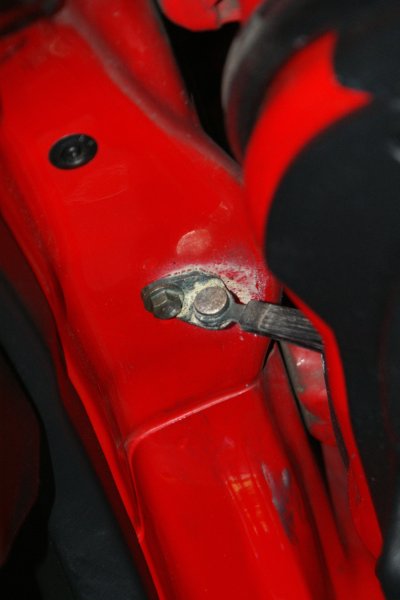
Photo 2: Grease has collected for a long time without being challenged. The worst part: the door still squeaked!
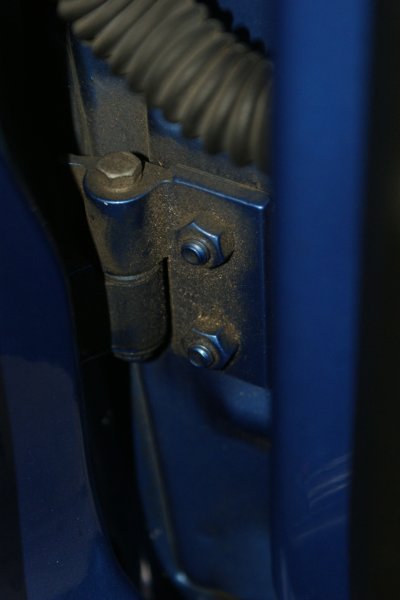
Doorjambs serve many purposes. First, they act as a seal between the door and the body, shielding the elements, wind, and temperatures from the cabin. Dirt many times accumulates in the jambs by design and is left to bake and freeze under sun and snow. Even more, these areas usually never get rinsed off when washed. Doorjambs also are the housings to the structures that allow the door to open and close; one or more hinges, door strikers, guides and knobs, each smothered in grease. Vehicle manufacturers and dealers slop up the doorjambs to prevent customer complaints about squeaks and noises from opening and closing the door. Most people will never look twice at the doorjambs, but that is not the case with a car enthusiast or hobbyist detailer, or you probably would not be on this website this right now.
Why clean your doorjambs? It makes it easier to clean in the future. It makes the car look better maintained, and cleaner overall. We really hate seeing filth on our cars any time we get in or out. We’ve wondered if passengers ever notice how bad they are (OK, were). But the best thing about cleaning your doorjambs is you will greatly decrease the risk of rust forming around your doors, and gives you a chance to do an early diagnostics of any problem areas arising. Remember; the dirt, grime, grease, and moisture accumulate in the jambs and can stay there for years. If your vehicle’s roof “gutters” drains into the doorjambs, you have a perfect place for farming rust. This is especially important for domestic pick-up trucks. Once clean and waxed, no dirt will ever last there, and keeping them clean will be a matter of a quick wipe with a Quick Detailer after every other wash or so.
This will also work for trunk jambs, engine bay jambs, behind the fuel door, etc.
So how do we clean them? In a simple word: patience.
Cleaning your doorjambs will take some effort, and crouching down or lying on the floor for the harder to reach areas. This is nothing complicated or difficult so anyone can do it. Set aside about 2 hours in the shade on a cool car. We prefer to do the jambs before washing the car.
We will refer to all parts of the door to body interface as the “jamb”. This includes the door edges, underneath, the A-pillar jamb area and the B-pillar jamb area. If a 4-door, then the C-pillar jamb areas and rear door edge too. The dirtiest areas are typically underneath the doors, so pay special attention there.
Photo 3: Prepared to start: Degreaser, P21S Total Auto Wash, Optimum No-Rinse solution, and brushes.
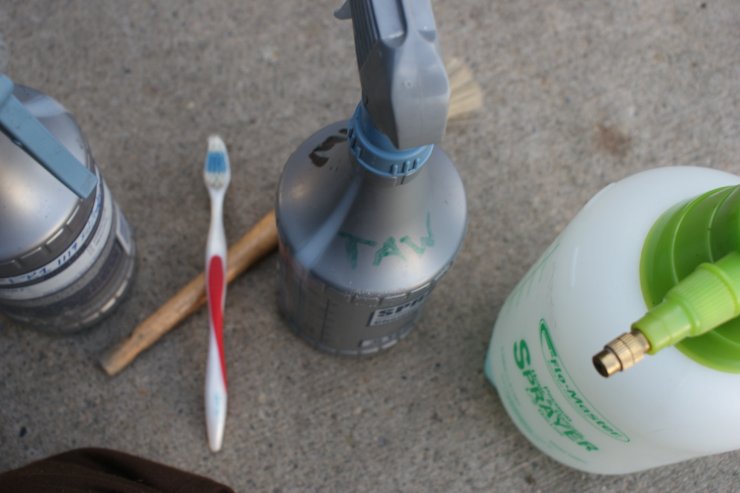
You will need a few smaller brushes with medium to long bristles, an old toothbrush or two, a few general purpose microfiber towels, and some cleaners. To start out with, Meguiar’s APC at 4:1 does a good job of loosening the grime, but any cleaner may take more than one application to get the jambs sparkling (you can also do the jambs little by little with each time you wash). You will also need a spray bottle filled with warm water, or if possible, some Optimum No-Rinse mix, to flush the loosened grime and chemicals from the finish.
Remember this is a painted area and therefore deserves special care in the same way as the rest of your finish. Brushes must be soft as to not cause marring or swirls in the jambs. As you can imagine, polishing out swirls from the doorjambs is almost impossible in certain areas. Also, do not let the cleaners dry upon the surface. Start with one door and stick to it until you can rinse it off. Don’t try to do too much too quick and spray all doors with APC, then have to hurry up to keep it from drying.
Once you have on your nitrile gloves, spray the APC directly into the doorjamb. Don’t be shy! Make sure to keep the spray from falling on your interior surfaces (it will clean away any dressings and can stain interior plastic at this strong of a concentration). Let dwell for 30 seconds, and start to agitate with the brushes. Use the toothbrush for hidden areas, and where components bolt to the body (like the hinges, etc.). Make sure to brush off the rubber casing that carries your electrical connections from the body into the door. Try not to spray APC into the door latch itself. Instead, spray the brush lightly, brush off, and wipe the rest away leaving the latch mechanism clean and dry.
Photos 4 and 5: Degreaser has had some time to dwell on the hinge and jamb. Notice how the cleaning power of the chemical attacks the grime.


Focusing on the tricky areas. Make sure you clean around and underneath the rubber seals as good as possible. Take your time and repeat the process a few times. Get into the folds of the door seals. When wiping, get the towel up into the seal crevice. If it turns dirty, repeat the cleaning. This is the stuff that will stay there forever if you don’t get it now, and if it contacts metal, can cause the doors to rust prematurely.
Photos 6 and 7: The BMW M3 now in proper form after a final wipe with quick detailer and a clean microfiber towel.
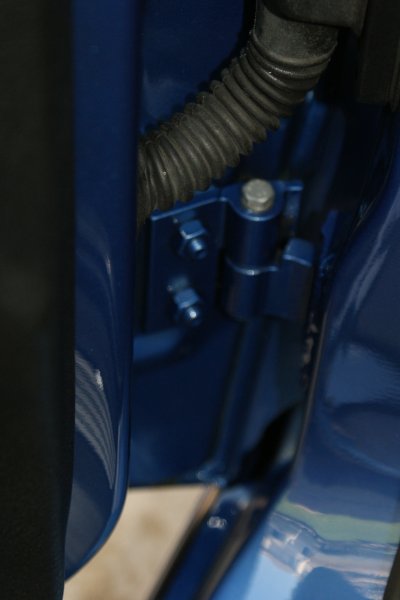
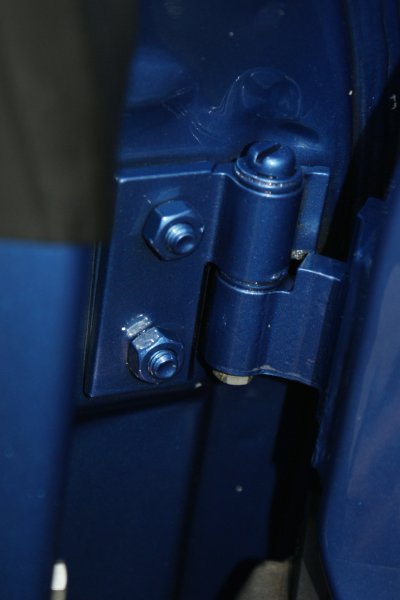
As you brush you will notice the grime that is coming off. Keep spraying new APC to clean further, but remember to rinse off the APC every once in awhile, before it dries on the surface. Once clean enough, spray off excess with your water bottle or Optimum No-Rinse mix. Try to use the stream pattern (open the nozzle tip a bit more) and get water to force the grime and APC out of the crevices. Alternatively, and only for the very brave or Jeep owners, use your pressure hose and spray off the doorjamb (this WILL get your interior very wet and can fry your electronics, damage your leather, etc.). Once rinsed, wipe off the excess moisture and any streaks of grease still present.
Once dry, use a Quick Detailer or Spray Wax and spray down the jambs. Wipe off and buff with a soft microfiber towel to reveal a slick, clean doorjamb.
Photos 8 and 9: After wiping off the cleaners, the door smiles back at you!

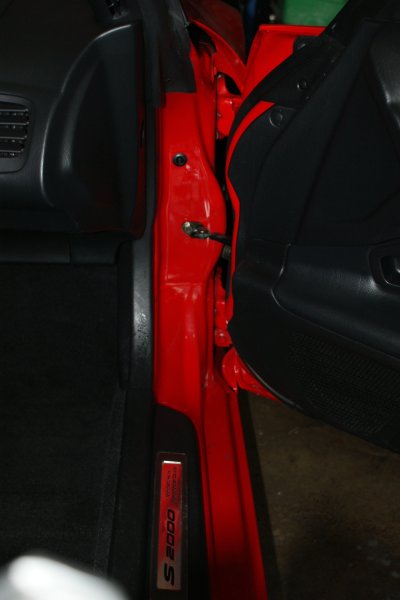
Photos 10 through 13: Protecting area from overspray, spraying the cleaner, agitating with a brush, jamb wiped clean and dry.
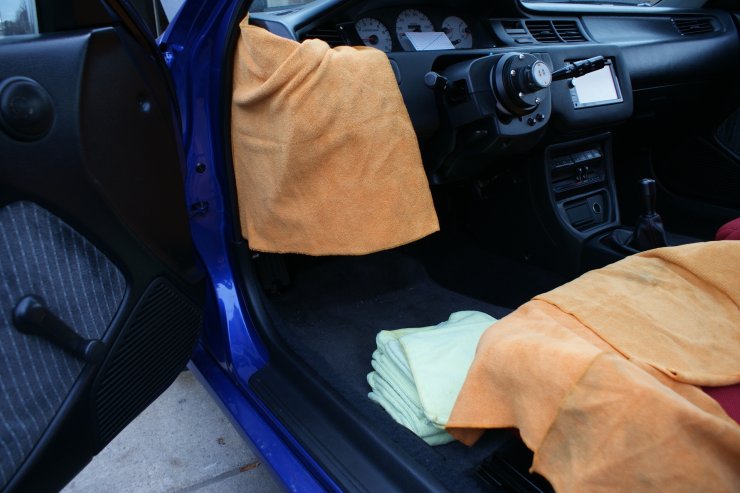
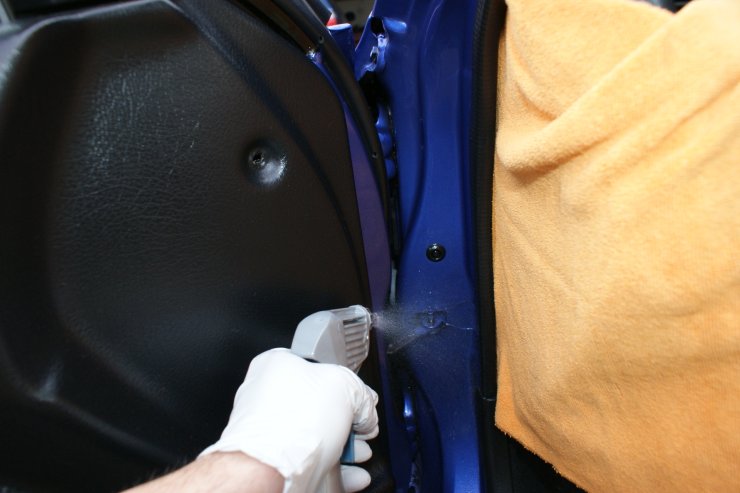
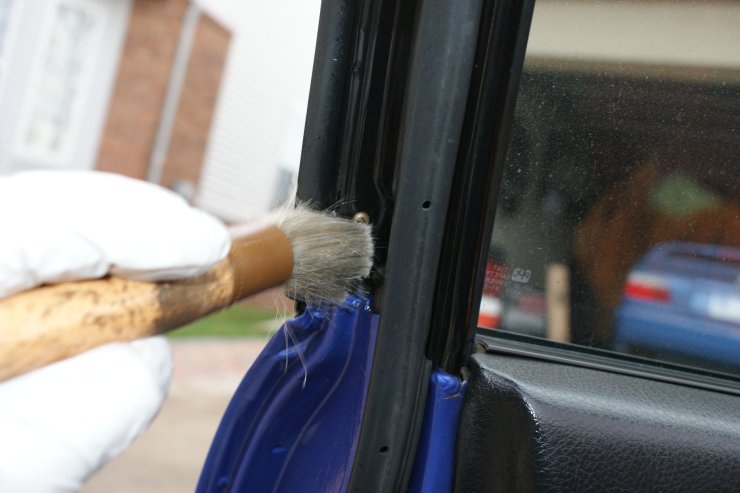
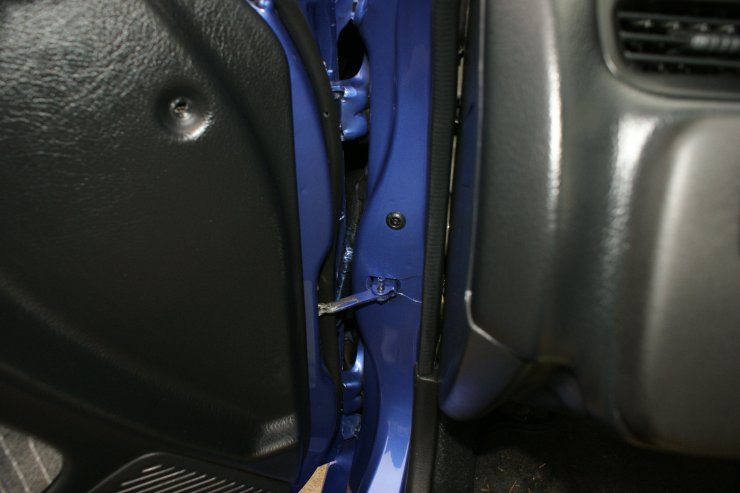
Photos 14 through 16: Degreaser working, wiped clean, close up of cleanliness.
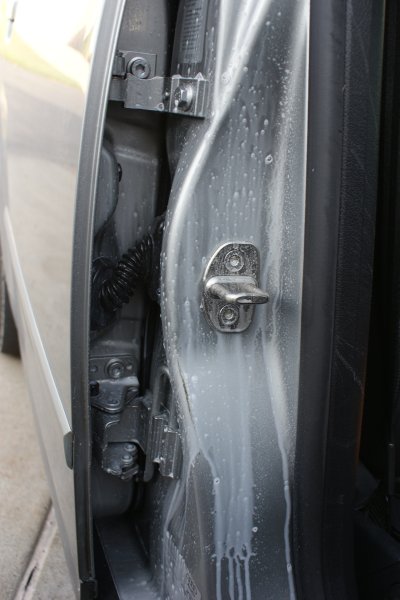
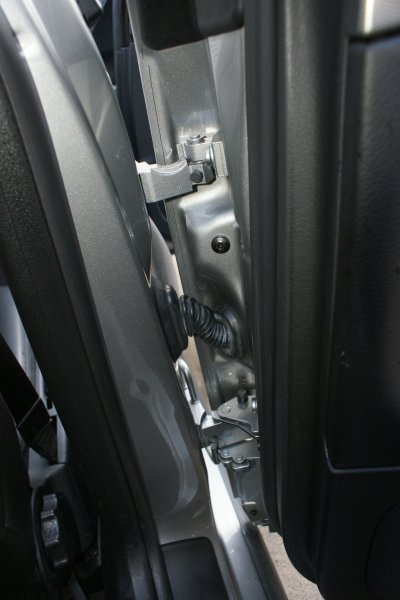
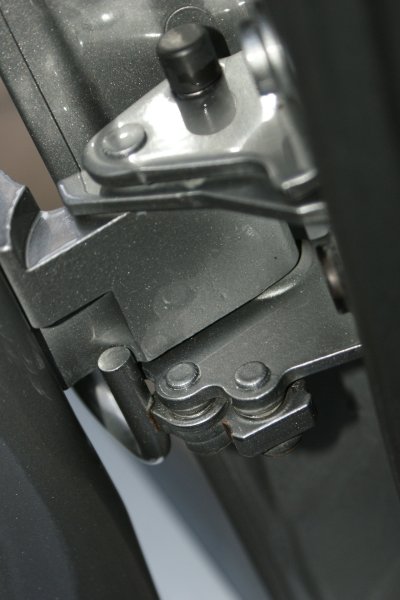
Options:
If the grime is really tough, use a stronger yet safe cleaner like P21S Total Auto Wash. Just be cautious when using other very strong cleaners and strong ratios though because you could potentially run the risk of damaging something you do not intend to.
While washing the exterior of a vehicle with a pressure washer, open and slightly close the door so it is latched but not fully closed (you would need to pull the handle to unlatch or bump the door again to shut it). Spray into the jamb with a fan spray to use the water’s velocity to yank out grime and dirt. This can get your interior very wet if the seals are not contacting the frame, but in most cars it will only get slightly damp. The high-pressure water is a very powerful tool for getting really caked-in stuff off.
You can hand polish the larger, open areas of the jamb, quite easily with some M205, or Klasse AIO on a foam applicator. Just like the exterior of the car: the more polished the better your results will look.
Remember that with no grease anywhere, your doors will squeak. I found a clear grease lubricant packaged in a syringe at my local auto parts store that permits me to administer lube exactly where I want it, while keeping it off the visible areas.
We certainly hope this article helps some fellow car enthusiasts, and feel free to ask questions or share your door-jamb tips in the comments!








Marc – EXCELLENT write up. I was actually washing my car yesterday and was thinking about how to clean the door jambs as they are filthy. Now I have this write-up to assist me. Thanks!
Mo,
Thank you for your kind feedback! I hope this may assist a fellow enthusiast on how to better care for his or her prized possession
I’ve been cleaning my jambs EVERY time I wash the car (every two weeks) for the past year, and I still find grime in some obscure nook or cranny each time. But I must say that once they’re clean, it takes very little effort to keep them that way and the car ALWAYS looks great!
great write up. just curious though, you say wash the door jambs before you clean the car. What about when you polish the car? Polish particles will find their way in the door jambs, no? Thanks!
They certainly will. But polish comes off much easier than grease. If your jambs are already clean and protected, polish will most likely be washed away with the hose. Any remainder will be easily removed with a MF towel.
When we say to clean the jambs before washing the car, it is so any overspray of harsh cleaners does not fall on clean or waxed paint. The same applies to cleaning any dirty part of you vehicle: engine, wheels, etc. Do these areas before cleaning the paint.
So is the only purpose for grease to avoid squeaking? Is it not a rust inhibitor?
Just wondering if after cleaning you do not re-grease and if the doors do not squeak, can you leave the grease off?
Thanks. Very helpful site.
I was thinking the same ting Marlene, funny they never replied to you answering your question.
You’d think the grease is an inhibitor for rust to protect the nuts, bolts and hinges from moisture and for noise prevention.
Not sure if you want to really remove ALL the grease.
I just use a lightly damp cloth and remove all the dirt and grime and not so much of the grease.
Just in case.
Hello Marc, Great info. Can I use a hand-held streamer to clean the door jams, trunk edge and hub caps? Also is the Mr. Clean magic eraser too vile for the paint? Thank You.
Hi Ms. Kerry,
You can use a steamer for a variety of uses on your car. Remember to first and foremost remove any large debris from those areas you want to clean. Steam will likely be both effective and safe on the areas you mentioned, but always be careful as you don’t want to damage something. Plastic, rubber, and other materials won’t take as kindly to the heat as metal will.
NO Magic Erasers! While they work well on black plastic molding that many modern cars have, they’re too abrasive for softer finishes like your paint and leather.
Thanks for the comment!
Unsure how I missed this before but GREAT article guys! Door jamb/trim restoration is tedious work but necessary to complete the package!
Thank you Patrick! As you know, many times it is the smaller things that really make a car feel “new.”
Hopefully this thread still has an author!
I need help cleaning tobacco stains out of the door jambs of my white miata!
I just picked this car up in a neat trade, very nice running little car – but so smoke damaged!
I have managed to clean the interior and get the smell out – but the door jambs are a disgusting yellow!
How can I remove this yellow stain from the white paint and restore it to it’s original finish?
Thanks!
This cleaner called AWESOME at the Dollar Store will melt away nicotine yellow all day long. good stuff and harmless…
Quick question. Got a 2013 Dodge Ram 1500 and the jambs look good except the hinges are starting to get a thin rust coat on them. I don’t wanna just spray wd40 or something all in there so what’s a good product to use for that?
Hello Marc and Jacob, the article you posted has helped me a lot. But, I’d like to know if not cleaning it properly could cause any damage. Thanks!
What do you use instead of lithium grease after detailing the door jambs? I’ve always used WD-40, but would like something that lasts a bit longer but does not attract dust and dirt. Any good ideas?
[…] 6. Cleaning Door Jambs and Other Filthy Places on an … […]